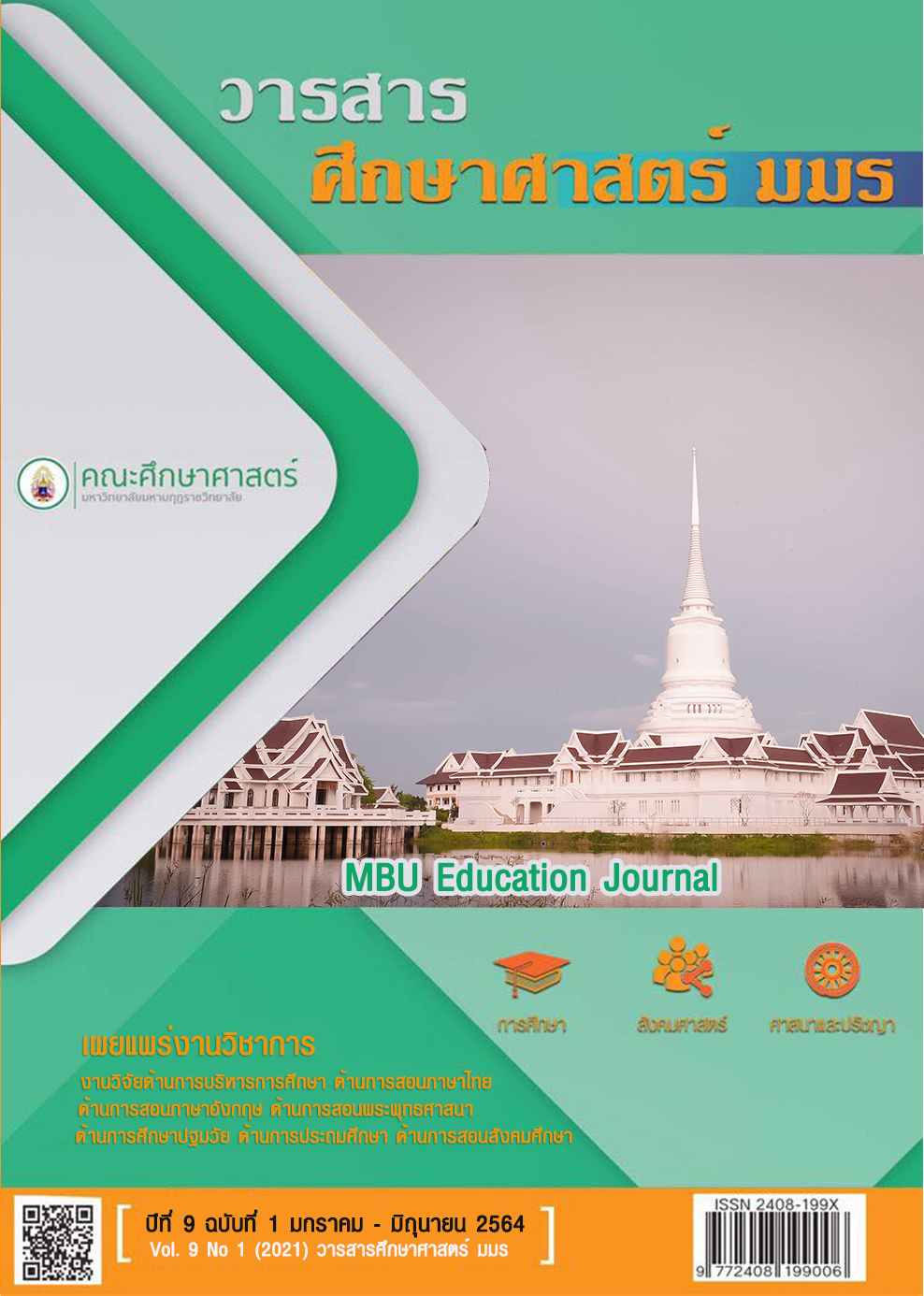การพัฒนาตัวชี้วัดพฤฒพลังของผู้สูงอายุไทย
คำสำคัญ:
พฤฒพลัง, การวิเคราะห์องค์ประกอบเชิงยืนยัน, ผู้สูงอายุไทยบทคัดย่อ
การวิจัยครั้งนี้มีวัตถุประสงค์เพื่อ 1) เพื่อพัฒนาตัวชี้วัดพฤฒพลังของผู้สูงอายุไทย 2) เพื่อตรวจสอบความสอดคล้องของโมเดลตัวชี้วัดพฤฒพลังของผู้สูงอายุไทยกับข้อมูลเชิงประจักษ์ กลุ่มตัวอย่าง ที่ใช้ในการวิจัย คือ ผู้สูงอายุไทยจำนวน 600 คน ได้จากการสุ่มตัวอย่างแบบหลายขั้นตอน (Multi-stage sampling) เครื่องมือที่ใช้ในการวิจัยเป็นแบบสอบถามมาตรประมาณค่า 5 ระดับ จำนวน 73 ข้อ สถิติที่ใช้ในการวิเคราะห์ข้อมูล ได้แก่ ค่าเฉลี่ย ส่วนเบี่ยงเบนมาตรฐาน ความเบ้ ความโด่ง ค่าสัมประสิทธิ์สหสัมพันธ์เพียร์สันด้วยโปรแกรมสำเร็จรูป (SPSS) และการวิเคราะห์องค์ประกอบเชิงยืนยันอันดับที่สองด้วยโปรแกรม (LISREL 8.72)
ผลการวิจัยพบว่า
1. ตัวชี้วัดพฤฒพลังของผู้สูงอายุไทย ประกอบด้วย 5 ตัวชี้วัดหลัก และ 17 ตัวชี้วัดย่อย ดังนี้ 1) ด้านสุขภาพกาย ประกอบด้วย 4 ตัวชี้วัดย่อย 2) ด้านสุขภาพจิต ประกอบด้วย 3 ตัวชี้วัดย่อย 3) ด้านสติปัญญา ประกอบด้วย 3 ตัวชี้วัดย่อย 4) ด้านการมีส่วนร่วม ประกอบด้วย 4 ตัวชี้วัดย่อย 5) ด้านความมั่นคง ประกอบด้วย 3 ตัวชี้วัดย่อย ผลการวิเคราะห์ข้อมูลพบว่า ทุกตัวชี้วัดที่สร้างขึ้นมีความสอดคล้องกับเกณฑ์ที่กำหนด เป็นตัวชี้วัดมีคุณภาพและมีความเหมาะสมในการชี้วัดพฤฒพลังของผู้สูงอายุไทย
- ผลการตรวจสอบโมเดลการวัดตัวชี้วัดพฤฒพลังของผู้สูงอายุไทยกับข้อมูลเชิงประจักษ์ด้วยการวิเคราะห์องค์ประกอบเชิงยืนยันอันดับที่สอง พบว่า โมเดลการวัดมีความสอดคล้องกับข้อมูลเชิงประจักษ์ ดังที่ค่าไค-สแควร์เท่ากับ 185.71 p-value เท่ากับ 0.000 ณ องศาความเป็นอิสระที่ 86
ค่าไค-สแควร์สัมพัทธ์ ( /df) เท่ากับ 2.16 ค่าดัชนีวัดระดับความสอดคล้องเปรียบเทียบ (CFI) เท่ากับ 0.99 ค่าดัชนีวัดระดับความกลมกลืน (GFI) เท่ากับ 0.96 ค่าดัชนีวัดระดับความกลมกลืนที่ปรับแก้แล้ว (AGFI) เท่ากับ 0.94 ค่ากำลังสองเฉลี่ยของเศษ (RMR) เท่ากับ 0.029 และค่าดัชนีรากที่สองของค่าเฉลี่ยความคลาดเคลื่อนของการประมาณค่า (RMSEA) เท่ากับ 0.044
References
กุศล สุนทรธาดา และ กมลชก ขําสุวรรณ. (2553). ระดับและแนวโน้มความมีพฤฒิพลังของผู้สูงอายุไทย. การประชุมวิชาการประชากรศาสตร์แห่งชาติ 2553 : 26-38
จิราพร เกศพิชญวัฒนา และคณะ. (2549). รายงานการวิจัย โครงการพฤฒพลัง: กรณีศึกษาจากผู้สูงอายุที่ได้รับการยอมรับในสังคม. กรุงเทพฯ: สํานักงานกองทุนสนันสนุนการสร้างเสริมสุขภาพ.
เพ็ญแข ประจนปัจจนึก. (2550). รายงานวิจัยฉบับสมบูรณ์เรื่องการจัดการศึกษาและการเรียนรู้ตลอด ชีวิตเพื่อเตรียมความพร้อมในการพัฒนาภาวะพฤฒิพลังของผู้สูงอายุไทย. กรุงเทพฯ: สํานักงานกองทุนสนับสนุนการวิจัย.
ระวี สัจจโสภณ. (2556). แนวคิดทางการศึกษาเพื่อการพัฒนาภาวะพฤฒิพลังในผู้สูงอายุ. วารสารเกษตรศาสตร์(สังคม), 34, 471-490.
วิไลพร วงค์คีนี, โรจนี จินตนาวัฒน์, และกนกพร สุคําวัง. (2556). ปัจจัยทำนายพฤฒพลังของประชากร เขตเมืองจังหวัดเชียงใหม่. พยาบาลสาร, 40(4), 91-99.
ศุภเจตน์ จันทร์สาส์น. (2555). พฤฒิพลังของผู้สูงอายุไทย การปันผลทางประชากร และโอกาสทาง เศรษฐกิจของประเทศไทยในสังคมสูงวัย. วารสารศรีนครินทรวิโรฒวิจัยและพัฒนา, 4(7), 201-214.
สถาบันวิจัยประชากรและสังคม มหาวิทยาลัยมหิดล. ประชากรสูงอายุ. เรียกใช้เมื่อ 24 กุมภาพันธ์ 2564 จาก สถาบันวิจัยประชากรและสังคม มหาวิทยาลัยมหิดล: http://www.thailandometers.mahidol.ac.th/#elderly.
สำนักงานสถิติแห่งชาติ. (2560). ดัชนีพฤฒพลังผู้สูงอายุไทย. กรุงเทพฯ: สำนักงานสถิติแห่งชาติ.
สุภจักษ์ แสงประจักษ์สกุล. (2558). ปัจจัยกําหนดระดับวุฒิวัยของผู้สูงอายุไทย. วารสารสงขลา นครินทร์ ฉบับสังคมศาสตร์และมนุษยศาสตร์, 21(1), 139-167.
สุทธิชัย จิตะพันธ์กุล. (2545). “Active ageing” เรือธงลำใหม่ในศวรรษที่ 21. วารสารพฤฒาวิทยา และเวชศาสตร์ผู้สูงอายุ, 2(4), 1-3.
International Longevity Centre Brazil (ILC-Brazil). (2015). ACTIVE AGEING: A Policy Framework in Response to the Longevity Revolution. Brazil: ILC.
Thanakwang K., Soonthorndhada K. (2006). Attributes of active ageing among older persons in Thailand: evidence from the 2002 survey. Asia-Pacific Population Journal, 21(3), 113-135.
Unece. (2013). Active Ageing Index 2012: Concept, Methodology and Final Results. Vienna, Australia: United Nations Economic Commission for Europe.
WHO. (2002). Active Ageing: A Policy Framework. Geneva, Switzerland: World Health Organization.



